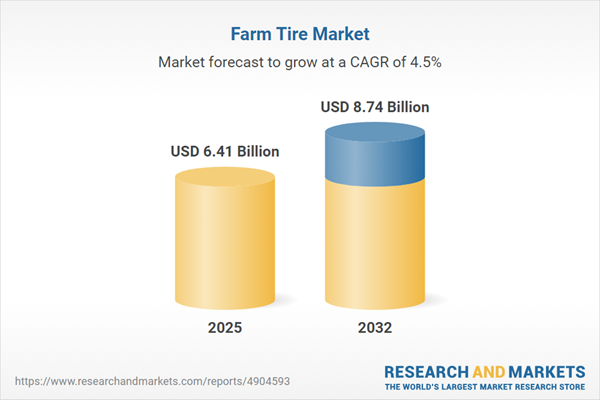Speak directly to the analyst to clarify any post sales queries you may have.
The farm tire market is undergoing substantial transformation as advanced cultivation methods, sustainability initiatives, and technological integration reshape demand and value delivery. These shifts are prompting key players to adopt new solutions to address evolving operational and regulatory requirements in agriculture.
Market Snapshot: Farm Tire Market Size and Growth Trajectory
The farm tire market grew from USD 6.13 billion in 2024 to USD 6.41 billion in 2025. It is forecast to maintain robust expansion at a CAGR of 4.53%, reaching USD 8.74 billion by 2032. Market growth is sustained by the convergence of technology, efficiency, and regulatory drivers across agriculture’s global landscape, requiring tires that meet diverse and complex field demands.
Scope & Segmentation: Comprehensive View of Farm Tire Market
This research evaluates the full spectrum of the sector, encompassing product design, technology integration, application contexts, and distribution models with special attention to global and regional nuances.
- Tire Types: Bias, Radial
- Applications: Combine, Harvester, Tractor (Orchard, Row Crop, Utility), Trailer
- Farm Size: Large, Medium, Small
- Distribution Channels: Aftermarket (Online, Retail Dealer), OEM
- Regional Coverage: Americas (North America—United States, Canada, Mexico; Latin America—Brazil, Argentina, Chile, Colombia, Peru); Europe, Middle East & Africa (Europe—United Kingdom, Germany, France, Russia, Italy, Spain, Netherlands, Sweden, Poland, Switzerland; Middle East—United Arab Emirates, Saudi Arabia, Qatar, Turkey, Israel; Africa—South Africa, Nigeria, Egypt, Kenya); Asia-Pacific (China, India, Japan, Australia, South Korea, Indonesia, Thailand, Malaysia, Singapore, Taiwan)
- Key Market Players: Titan International, Inc.; Compagnie Générale des Établissements Michelin SCA; Trelleborg AB; Bridgestone Corporation; Continental AG; Balkrishna Industries Limited; Yokohama Rubber Company, Limited; Pirelli & C. S.p.A.; Alliance Tire Group Ltd; Mitas a.s.
Key Takeaways for Senior Decision-Makers
- Innovation leads the market, with both OEMs and aftermarket suppliers investing in novel rubber compounds, digital monitoring, and structural improvements to optimize performance and minimize downtime.
- Environmental and soil conservation strategies are elevating demand for advanced tire designs that effectively balance flotation, traction, and durability while lowering compaction.
- Collaboration among manufacturers, equipment producers, and agri-tech specialists is accelerating real-time analytics and predictive maintenance integration into tire solutions, fostering a more resilient agricultural value chain.
- Regional variances shape tire preferences: North America prioritizes high-performance and machine integration, EMEA focuses on sustainability and retreading, and Asia-Pacific emphasizes access and adaptability for small to medium farms.
- Procurement decisions are becoming more dynamic; larger agricultural enterprises seek premium, telemetry-enabled solutions, while smaller operations often prioritize cost-effective and versatile tire options.
- Distribution networks have adapted, offering streamlined online channels alongside traditional dealer expertise to facilitate efficient purchasing and support.
Tariff Impact: Navigating U.S. Import Duties on Farm Tires
The imposition of import duties on farm tires entering the United States has added new supply chain challenges and shifted cost structures. Tariffs have extended lead times, influenced sourcing and inventory approaches, and encouraged some manufacturers to localize production to reduce exposure. Tactical renegotiation of contracts and diversified supplier strategies are integral in managing these effects while supporting continued channel resilience.
Methodology & Data Sources
Analysis combines primary interviews with tire producers, OEM representatives, distributors, and end-users, alongside secondary research from industry reports and regulatory documentation. Quantitative insights are developed from shipment data and equipment registrations, with scenario analyses and validation protocols ensuring accuracy and reliability throughout the research process.
Why This Report Matters: Data-Driven Decisions for Leadership
- Enables benchmarking against evolving market drivers—technological, regulatory, and environmental—for informed product, procurement, and partnership strategies.
- Delivers granular segmentation and regional insights so manufacturers and distributors can align portfolio development with market-specific customer expectations and compliance standards.
- Supports senior management in risk mitigation and investment prioritization, empowering agile response to shifts in tariffs, sustainability mandates, and competitive dynamics.
Conclusion: Outlook for Farm Tire Market Leadership
As the farm tire ecosystem continues to evolve, forward-thinking organizations that leverage innovation, strengthen collaborations, and adapt to regional market requirements will sustain long-term success and secure strategic advantage.
Additional Product Information:
- Purchase of this report includes 1 year online access with quarterly updates.
- This report can be updated on request. Please contact our Customer Experience team using the Ask a Question widget on our website.
Table of Contents
3. Executive Summary
4. Market Overview
7. Cumulative Impact of Artificial Intelligence 2025
Companies Mentioned
The companies profiled in this Farm Tire market report include:- Titan International, Inc.
- Compagnie Générale des Établissements Michelin SCA
- Trelleborg AB
- Bridgestone Corporation
- Continental AG
- Balkrishna Industries Limited
- Yokohama Rubber Company, Limited
- Pirelli & C. S.p.A.
- Alliance Tire Group Ltd
- Mitas a.s.
Table Information
| Report Attribute | Details |
|---|---|
| No. of Pages | 195 |
| Published | October 2025 |
| Forecast Period | 2025 - 2032 |
| Estimated Market Value ( USD | $ 6.41 Billion |
| Forecasted Market Value ( USD | $ 8.74 Billion |
| Compound Annual Growth Rate | 4.5% |
| Regions Covered | Global |
| No. of Companies Mentioned | 11 |









